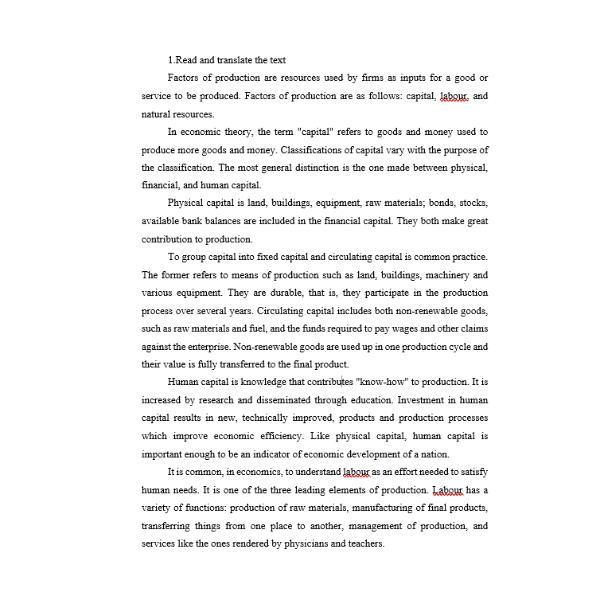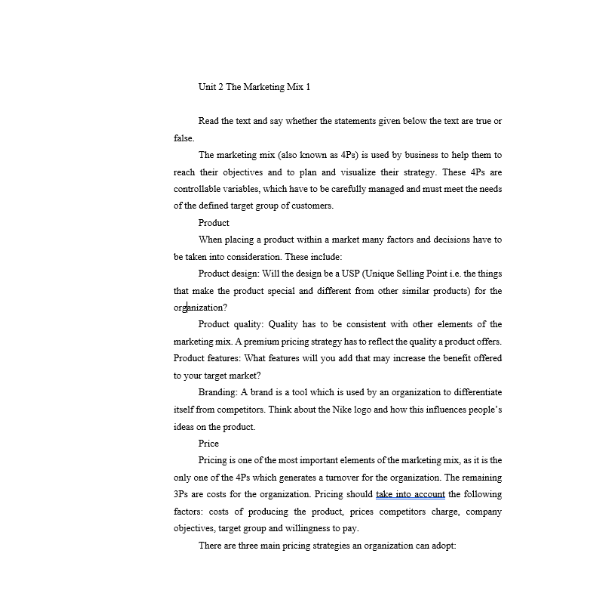The labour market
200 pуб.
Купить
В наличии: 0
шт.
The labour market
1.Read and translate the text
In many ways the relationship between employers and workers is similar to the relationship between consumers and producers: workers offer a service (the labour they provide), employers buy that service at a price they can afford (the wages they pay). As you can see, it's a kind of market. In economics, it's called the labour market.
In any market for products and services, consumers try to get the maximum utility, or satisfaction, from their purchase. This is the same in the labour market. What do companies want from their purchase of labour? What utility do they get? The answer is increased output. Output is how much of the product or service the company produces. If there is an increase in demand for their product, they will need to increase output. One way to do this (but not the only way) is to take on more staff. Another is to ask staff they already have to work more hours. In both cases, the company is buying more labour.
Just like any other market, the labour market obeys the laws of supply and demand. The demand is the employers' need for labour. Supply is the labour workers provide. Just like any other commodity, there is a relationship between price and demand. As the price of labour increases, the demand decreases.
The suppliers in the labour market are workers. Just like suppliers in other markets, they want a higher price for greater supply. In other words, as supply of labour increases, they want higher wages. The wage that workers get for their labour is a compromise between what they want and what companies will pay.
However, there can be shifts in demand. These shifts can cause the overall demand for labour to increase or decrease at any wage rate. For example, if there is an increase in the demand for the end product or service, there will be an overall increase in demand for labour (the demand curve shifts to the right). However, if new technology can replace workers, then there will be an overall decrease in demand for labour (the demand curve shifts to the left).
One more thing which affects demand for labour is workers' productivity. The productivity of a worker is how much they produce in a certain time. For example, imagine that a worker makes ten pencils an hour one day, and only eight pencils an hour the next day. This is a fall in productivity. When worker productivity falls, companies will pay less for labour. They are also less likely to employ new workers.
2. Match the words and their definitions.
1. take on A. employees
2. obey B. satisfaction or usefulness
3. utility C. be able to buy
4. output D. follow
5. compromise E. amount produced in a certain time
6. productivity F. employ more staff
7. afford G. both sides give up something in order to agree
8. staff H. what a company produces
3. Decide whether the following statements are True or False.
1. The relationship between employers and workers is similar to the relationship between buyers and manufacturers.
2. Clients try to get as much satisfaction from their purchase as possible.
3. If there is decline in demand for their product, company will need to increase output.
4. The only way to increase output is to take on more staff.
5. The labour market is obliged to adopt the rules of supply and demand.
6. As the price of labour rises, the demand declines.
7. The productivity of a worker is the amount of production in a certain time.
4. Answer the questions.
1. The amount of product or service that compony produces, is ____.
A. Input B. Output
2. What is the compromise between what workers want and what companies will pay?
A. Wage B. Bonus
3. What will happen if new technology replace workers?
A. Decrease in demand for labour B. Increse in demand for labour
4. How is the amount of production by workers in certain time called?
A. Production B. Productivity
5. What laws does the labour market obey?
A. The laws of supply and demand B. The law of import and export
5. Complete the sentences below
1. The labour market is similar to ....
2. Companies buy labour because they ....
3. Workers want higher ....
4. When the price of labour rises ....
5. Four things that cause a change in demand for labour are ....
6. Fill the gaps with prepositions where neccessary.
The demand ....(1) factors ....(2) production depends ....(3) the demands ..... (4)the firm's ..... (5)output.
..... (6)workers receiving wages, a self-employed man receives profit.
In some industry specific human capital may be .... (7) high demand and short supply and other human capital may be .... (8) excess supply.
Increases .... (9) the quantities demanded typically vary .... (10) different goods as incomes rise.
7. Think about this question and give detailed answer.
What makes workers more or less productive? Which things affect productivuty?
1.Read and translate the text
In many ways the relationship between employers and workers is similar to the relationship between consumers and producers: workers offer a service (the labour they provide), employers buy that service at a price they can afford (the wages they pay). As you can see, it's a kind of market. In economics, it's called the labour market.
In any market for products and services, consumers try to get the maximum utility, or satisfaction, from their purchase. This is the same in the labour market. What do companies want from their purchase of labour? What utility do they get? The answer is increased output. Output is how much of the product or service the company produces. If there is an increase in demand for their product, they will need to increase output. One way to do this (but not the only way) is to take on more staff. Another is to ask staff they already have to work more hours. In both cases, the company is buying more labour.
Just like any other market, the labour market obeys the laws of supply and demand. The demand is the employers' need for labour. Supply is the labour workers provide. Just like any other commodity, there is a relationship between price and demand. As the price of labour increases, the demand decreases.
The suppliers in the labour market are workers. Just like suppliers in other markets, they want a higher price for greater supply. In other words, as supply of labour increases, they want higher wages. The wage that workers get for their labour is a compromise between what they want and what companies will pay.
However, there can be shifts in demand. These shifts can cause the overall demand for labour to increase or decrease at any wage rate. For example, if there is an increase in the demand for the end product or service, there will be an overall increase in demand for labour (the demand curve shifts to the right). However, if new technology can replace workers, then there will be an overall decrease in demand for labour (the demand curve shifts to the left).
One more thing which affects demand for labour is workers' productivity. The productivity of a worker is how much they produce in a certain time. For example, imagine that a worker makes ten pencils an hour one day, and only eight pencils an hour the next day. This is a fall in productivity. When worker productivity falls, companies will pay less for labour. They are also less likely to employ new workers.
2. Match the words and their definitions.
1. take on A. employees
2. obey B. satisfaction or usefulness
3. utility C. be able to buy
4. output D. follow
5. compromise E. amount produced in a certain time
6. productivity F. employ more staff
7. afford G. both sides give up something in order to agree
8. staff H. what a company produces
3. Decide whether the following statements are True or False.
1. The relationship between employers and workers is similar to the relationship between buyers and manufacturers.
2. Clients try to get as much satisfaction from their purchase as possible.
3. If there is decline in demand for their product, company will need to increase output.
4. The only way to increase output is to take on more staff.
5. The labour market is obliged to adopt the rules of supply and demand.
6. As the price of labour rises, the demand declines.
7. The productivity of a worker is the amount of production in a certain time.
4. Answer the questions.
1. The amount of product or service that compony produces, is ____.
A. Input B. Output
2. What is the compromise between what workers want and what companies will pay?
A. Wage B. Bonus
3. What will happen if new technology replace workers?
A. Decrease in demand for labour B. Increse in demand for labour
4. How is the amount of production by workers in certain time called?
A. Production B. Productivity
5. What laws does the labour market obey?
A. The laws of supply and demand B. The law of import and export
5. Complete the sentences below
1. The labour market is similar to ....
2. Companies buy labour because they ....
3. Workers want higher ....
4. When the price of labour rises ....
5. Four things that cause a change in demand for labour are ....
6. Fill the gaps with prepositions where neccessary.
The demand ....(1) factors ....(2) production depends ....(3) the demands ..... (4)the firm's ..... (5)output.
..... (6)workers receiving wages, a self-employed man receives profit.
In some industry specific human capital may be .... (7) high demand and short supply and other human capital may be .... (8) excess supply.
Increases .... (9) the quantities demanded typically vary .... (10) different goods as incomes rise.
7. Think about this question and give detailed answer.
What makes workers more or less productive? Which things affect productivuty?




